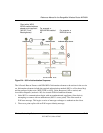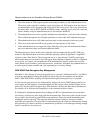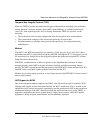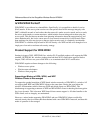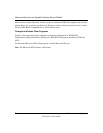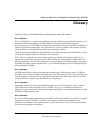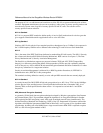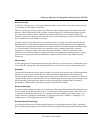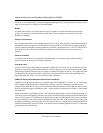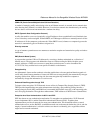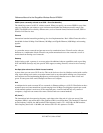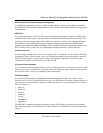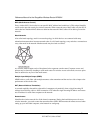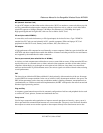
Reference Manual for the RangeMax Wireless Router WPN824
2 Glossary
202-10072-01, March 2005
The purpose of 11d is to add features and restrictions to allow WLANs to operate within the rules of these
countries. Equipment manufacturers do not want to produce a wide variety of country-specific products and
users that travel do not want a bag full of country-specific WLAN PC cards. The outcome will be
country-specific firmware solutions.
802.11e Standard
802.11e is a proposed IEEE standard to define quality of service (QoS) mechanisms for wireless gear that
gives support to bandwidth-sensitive applications such as voice and video.
802.11g Standard
Similar to 802.11b, this physical layer standard provides a throughput of up to 54 Mbps. It also operates in
the 2.4 GHz frequency band but uses a different radio technology in order to boost overall bandwidth.
802.11i
This is the name of the IEEE Task Group dedicated to standardizing WLAN security. The 802.11i Security
has a frame work based on RSN (Robust Security Mechanism). RSN consists of two parts: 1) The Data
Privacy Mechanism and 2) Security Association Management.
The Data Privacy Mechanism supports two proposed schemes: TKIP and AES. TKIP (Temporal Key
Integrity) is a short-term solution that defines software patches to WEP to provide a minimally adequate
level of data privacy. AES or AES-OCB (Advanced Encryption Standard and Offset Codebook) is a robust
data privacy scheme and is a longer-term solution.
Security Association Management is addressed by a) RSN Negotiation Procedures, b) IEEE 802.1x
Authentication and c) IEEE 802.1x Key management.
The standards are being defined to naturally co-exist with pre-RSN networks that are currently deployed.
802.11n Standard
A recently formed (Oct 2003) IEEE official task group referred to as: 802.11n or "TGn" for the 100 Mbps
wireless physical layer standard protocol. Current published ratification date is December 2005. As of
February 2004, no draft specification has been written - It is expected to use both the 2.4 and 5GHz
frequencies.
AES (Advanced Encryption Standard)
A symmetric 128-bit block data encryption technique developed by Belgian cryptographers Joan Daemen
and Vincent Rijmen. The U.S government adopted the algorithm as its encryption technique in October
2000, replacing the DES encryption it used. AES works at multiple network layers simultaneously. The
National Institute of Standards and Technology (NIST) of the U.S. Department of Commerce selected the
algorithm, called Rijndael (pronounced Rhine Dahl or Rain Doll), out of a group of five algorithms under
consideration, including one called MARS from a large research team at IBM. AES is expected to replace
WEP as a WLAN encryption method in 2003.




